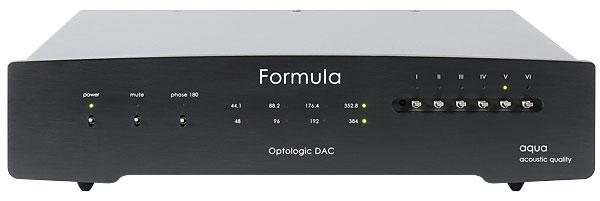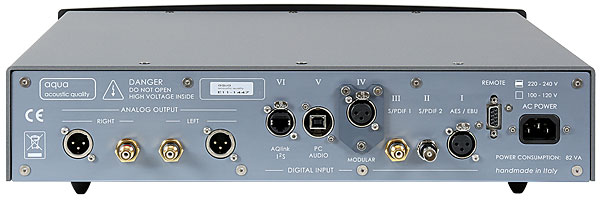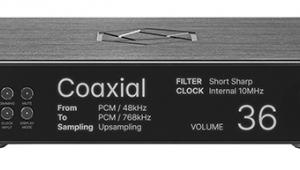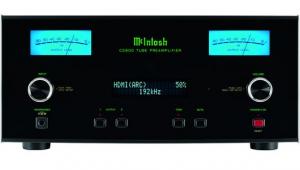Aqua Formula xHD Optologic Modular DAC

 The most novel high-end DACs often employ proprietary converter solutions instead of off-the-shelf chipsets. From Italy comes this unique take on the NOS 'ladder DAC'
The most novel high-end DACs often employ proprietary converter solutions instead of off-the-shelf chipsets. From Italy comes this unique take on the NOS 'ladder DAC'
As we've seen in the past, notably in our review of its La Voce S2 DAC [HFN Aug '16], Italian company Aqua, aka AQ Technologies, tends to follow its own path in the design and engineering of its products. Based in Milan, and just coming up to the tenth anniversary of its founding by chief engineer and product designer Cristian Anelli, it bases its work on what it describes as 'dedicated research with creative thinking'.
This has led to a select range of digital products: a £6495 CD transport called La Diva, and a choice of three DACs: the £3395 La Voce S3, the La Scala MkII at £6295 and the flagship £11,990 Formula xHD we have here. All three DACs share a common converter architecture, of which more in a moment, while the pricier two also incorporate what the company calls 'Optologic' technology. The latter refers to the fact that galvanic (and magnetic) isolation, between the DAC's analogue and digital sections, is achieved via opto-couplers. All the same, to describe this as 'our proprietary Optologic D/A conversion system' seems something of a stretch.
Steps To Success
More to the point is the digital-to-analogue conversion set-up here, which eschews off-the-shelf chip-based converters. Its solution is based on a 'ladder' of resistors for each channel or – as in the Formula xHD – two ladders per channel, operated in differential mode for improved resolution and noise cancellation. These are fed with a proprietary digital signal derived from the inputs, generated within a Field Programmable Gate Array (or FPGA).
The galvanic isolation bit comes in between the FPGA and the four 'branches' of the R-2R resistor ladders, thus keeping the entire digital conversion section, including the clocking, well away from any interference from the analogue circuitry, and vice-versa. In addition, the Formula xHD uses separate digital and analogue power supplies, all the way to a pair of C-core transformers and is built using discrete components, selected for sound quality and longevity.
The DAC uses no oversampling or digital filtering, and the analogue section is direct-coupled, with no capacitors in the signal path. The outputs are offered on either conventional unbalanced RCAs, or balanced XLRs fed from a transformer-coupled circuit – rare in consumer audio products, but de rigueur in the pro audio arena. Also, in common with all Aqua products, this one is of modular construction, with its various sections on separate circuitboards (all the way down to each 'ladder' here being on its own board), not just for ease of servicing but also to allow it to be upgraded in the future.
Well Connected
In fact, all three of the company's DACs have already been subject to upgrades and improvements. Not only did the original Formula gain the xHD improvements in format-handling, processing and performance, but the model we have here, to give it its full name, is actually the Formula xHD Rev2. All that aside, the Formula xHD is a pretty simple device, its controls running to nothing more than power, mute and phase inversion flip-switches, plus selectors for the bank of digital inputs to the rear.

In addition to what Aqua calls its AQlink input, an I2S port to match the similar connection on the La Diva transport, using an RJ45 connector, the Formula xHD also offers more standard coaxial digital ins. There's an AES/EBU socket, and an asynchronous USB-B for computer connection, using a proprietary USB receiver implemented on an FPGA. The latter is a fully floating, isolated design that, along with heavily revised firmware for the main FPGA in the conversion system, is central to the xHD's improvements.
Windows users will need to download a driver for the USB option, but as is usual the DAC is plug-and-play with Macs or Linux computers. In addition, the DAC has a modular option – an extra interchangeable input, able to offer an extra AES/EBU or RCA coax, AT&T fibre or an optical Toslink.
Between the switches on the front panel is a bank of LED indicators, which light singly or in pairs to show the type of input signal the DAC is receiving. The single lamps cover sampling rates up to 384kHz, while paired lamps indicate up to 768kHz, and one-bit audio up to DSD512. These higher rates, and input of DSD in native form, are only possible via the USB and AQLink connections as the 'conventional' digital inputs are limited to 192kHz, and DSD via DoP (the custom DSP within the Formula xHD necessarily converts DSD to LPCM to suit the R-2R ladder).
Hand Assembled
Again, as with other Aqua products, this flagship DAC is entirely hand-built in Italy, and the standard of finish is exceptionally high, with solid anti-resonance aluminium casework finished in Nextel, sitting on four pointed isolating feet and available in a choice of silver or black. So the Formula xHD may be unashamedly expensive, but it's a long way from your average 'chip package, analogue output, power supply and case' design, and there's an awful lot of components hand-assembled together in there.


















































